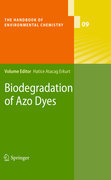
Azo dyes play an important role as coloring agents in the textile, food, and pharmaceutical industry. Due to the toxicity, mutagenicity and carcinogenicityof azo dyes and their breakdown products, their removal from industrial wastewaters has been an urgent challenge. Promising and cost-effective methods are based on their biodegradation, which is treated in this volume. The topics presented by experts in the field include: the classification of azo dyes; toxicity caused by azo dyes; aerobic and anaerobic azo dye biodegradation mechanisms; the role of bacteria, fungi, algae and their enzymes in biodegradation; the impact of redox mediators on azo dye reduction; the integration of biological with physical and chemical processes; the biotransformation of aromatic amines; reactor modelling for azo dye conversion; the biodegradation of azo dyes by immobilized bacteria and fungi; and factors affecting the complete mineralization of azo dyes." Treats different biodegradation methods so that the reader can compare them. Describes also the integration of biological with physical and chemical processes. Each chapter was written by an expert in the field. INDICE: Bioaugmentation of Azo Dyes.- Biodegradation of Azo Dyes Under Anaerobic Condition-Role of azoreductase.- Biodegradation of Azo Dyes in Anaerobic-Aerobic Sequencing Batch Reactors.- Decolorization of Azo dyes by Immobilized Bacteria.- Decolorization and Degradation of Azo Dyes by Redox Mediator Systems with Bacteria.- Bioreactors for Azo-Dye Conversion.- Treatment of Azo Dye-Containing Wastewater Using Integrated Processes.- Decolorization of Azo Dyes by White Rot Fungi.- Decolorization of Azo Dyes by Immobilized Fungi.- Decolorization of Azo Dyes by Yeasts.- Factors Affecting the Complete Mineralization of Azo Dyes.
- ISBN: 978-3-642-11846-3
- Editorial: Springer
- Encuadernacion: Cartoné
- Páginas: 214
- Fecha Publicación: 01/05/2010
- Nº Volúmenes: 1
- Idioma: Inglés
